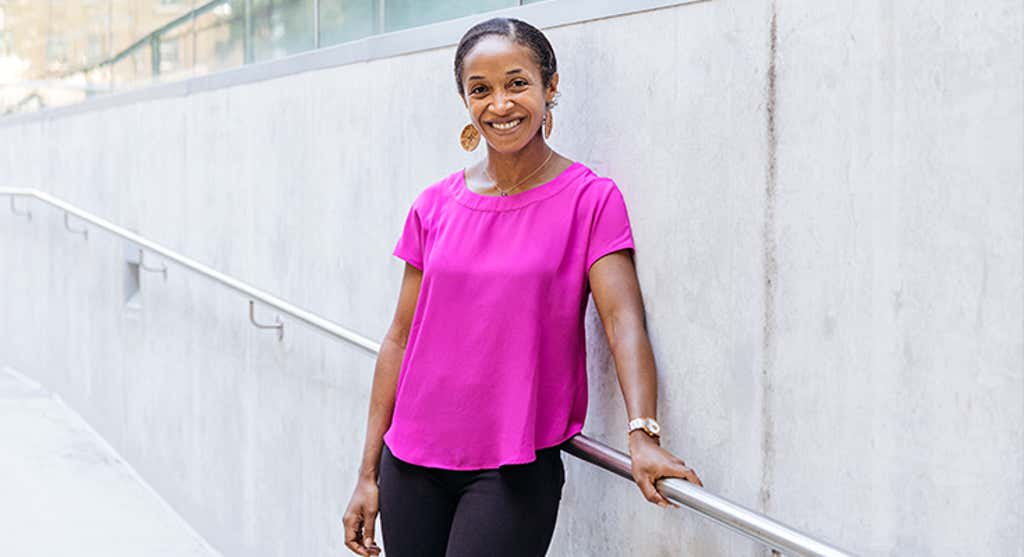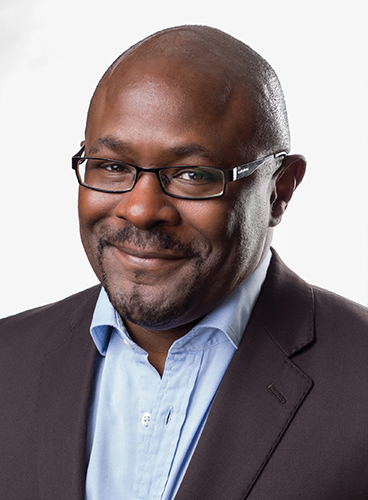
Race-based health disparities may be in the news, but they’re hardly new.
By Stuart Foxman
The numbers were shocking, but to Dr. Onye Nnorom they weren’t surprising. In late July, Toronto Public Health reported that Black people accounted for 21% of the city’s COVID-19 cases, despite making up 9% of the population. In all, people of colour comprise half of Toronto’s population but 83% of cases and 71% of those hospitalized with the virus. To put it another way, people who identified as Black and other people of colour were six to nine times more likely to test positive for COVID-19 than the white population.
What’s behind such outcomes? In the year of the pandemic, we can’t ignore something else that has long plagued society. Anti-Black racism is a public health crisis, says Dr. Nnorom, a family doctor and President of the Black Physicians’ Association of Ontario (BPAO).
Deep-rooted racism, discrimination and biases are all having a profoundly negative impact. “Their legacies lead to social and health inequities for Black people,” says Dr. Nnorom, who is also a professor at the Dalla Lana School of Public Health, University of Toronto.
How does anti-Black racism manifest itself in care delivery and outcomes? What can individual doctors, the system – including regulatory bodies like the CPSO — do to address the problem in a meaningful way?
Health disparities may be in the news, but they’re hardly new. The consequences aren’t confined to COVID-19, but the virus has thrown the issue into sharp focus. In Toronto, infection rates were strongly associated with low-income neighbourhoods, which have a disproportionate number of Black residents. Of course, Black people transcend all geographies and socio-economic groups. But what has been happening in those specific hot spots?
Consider more densely populated areas, filled with people who are less likely to have jobs that enable them to work from home. Residents had to head out to their lower-paying jobs, which perhaps lacked protective equipment, and where physical distancing was a challenge.

Peel away the layers. As Dr. Nnorom notes, when it comes to predisposition to disease, your postal code matters much more than your genetic code. Why haven’t people in these neighbourhoods had the same education or employment opportunities? What obstacles have they faced?
Black communities are disproportionately affected not just by COVID-19 but, historically, by diabetes, strokes, hypertension and mental health issues, among others. Race isn’t a risk factor for illness; racism is.
It’s not the only risk. But are its effects on health as recognized as they should be? “I don’t think there’s a fulsome understanding in medicine. We’re taught to focus on the biomedical model when thinking about race. But in a lot of cases, it comes down to racism,” says Dr. Aisha Lofters, a family physician at Women’s College Hospital in Toronto.
Are we really ‘in this together’?
Consider the social determinants of health. In January, leaders from Black communities and health systems gathered in Toronto for a Black Experiences in Health Care symposium. By the time the report on the event came out in April, COVID-19 had hit hard. Its disproportionate impact on Black people were already clear.

“The underlying causes of these disparate outcomes are not unique to the COVID-19-19 context,” stated the report. “The novel coronavirus has laid bare already existing rampant inequality, poverty, food and housing insecurity, and difficulties accessing appropriate health and social services that afflict Black populations in Canada and elsewhere. Mantras of us being ‘all in this together’ are proving to be false…and it assumes that there was equity in our socio-economic and health status pre-COVID-19-19.”
“If you take every one of the social determinants – which is a majority of risk of illness — all are more keenly felt in the Black population,” says Dr. Kwame McKenzie, CEO of the Wellesley Institute, and an international expert on equitable health systems and the social causes of illness.
The extent to which these impacts are entrenched in racism can’t be dismissed. Moreover, anti-Black racism is its own determinant. “We see differences in health outcomes regardless of socio-economic status,” says Dr. Nnorom.
The constant stress of racism
The effects of day-to-day prejudice, a sense of being the “other”, the feeling of having less power, negative encounters with the health-care system, a distrust of the system, or a feeling of being distrusted by the system — all of this also can’t be dismissed.
Black patients aren’t the only ones to feel these challenges; we’ll explore the experiences of other racialized and marginalized groups in future issues of Dialogue. The cumulative impact can be debilitating.
Dr. Sean Wharton, a Toronto internist and obesity specialist, mentions the toll of “weathering”. The constant stress of racism can affect your emotional and physical state.
“The stressors of being racialized just hurts so much, we internalize it,” says Dr. Wharton, medical director of Wharton Medical Clinic.
Groups aren’t monolithic. Experiences differ. But consider this assessment of the health status of Black Canadians, from a 2017 report: “Several factors contribute to health disparities, including historic barriers to access and continuity of health care, long-standing systemic racism, low socio-economic status, lack of cultural specificity in health education and under-representation of Black health professionals.” That indictment came from the outside looking in: a visiting United Nations working group.
When contemplating anti-Black racism, Canadians sometimes pat themselves on the back, especially when we compare ourselves to the U.S.
“That’s a common viewpoint,” says Dr. Lofters, who’s also an associate professor and clinician scientist in the Department of Family and Community Medicine, University of Toronto. “Race relations in the U.S. are terrible and aren’t we lucky we don’t have that in Canada. It’s easy to pretend the problems here don’t exist.”
According to the Race Relations in Canada 2019 Survey, 81% of Canadians say race relations in their own community are generally good. Yet 54% of Black respondents (and 53% of Indigenous ones) report ongoing race-related discrimination.
Canadians underestimate the scope of the problem, and Dr. Nnorom says so does the Canadian health-care community. “In medicine, I don’t think there’s an understanding of the extent of anti-Black racism,” she says.
Nor is there enough awareness by doctors of their own biases.
“One reason we might be oblivious to racism is the nature of our business. We serve all people, so many physicians feel they’re immune to racist beliefs,” says Dr. Dominick Shelton, an emergency physician and quality improvement lead at Sunnybrook Health Sciences Centre in Toronto. “Being altruistic and having biases aren’t mutually exclusive. We all have biases. The question is whether we bring them into our interactions with others.”
“Doctors need to think about the social factors that affect their patients’ lives, and re-evaluate how they treat their minoritized patients.”
DR. ONYE NNOROM
Talk to Black patients, and Black doctors, and they’ll share the anecdotes of how those biases can creep in.
“It plays out in more subtle moments,” says Dr. Lofters. “I’ve had Black patients confide to me that when they see other doctors it can feel like they’re not believed, or that they’re being talked down to.”
Dr. Wharton says that the management of chronic diseases is much less assertive and aggressive with Blacks. This can mean that Black patients’ symptoms are more easily dismissed, tests are not ordered the same way, and Blacks don’t always get the same discussion about treatment options. Some doctors will often make assumptions about what Black patients can afford, or about their overall health-care literacy.
Strip away all the determinants, and Dr. Wharton says you still find instances where a doctor might treat a white patient differently from a Black patient.
He cites too the phenomenon of Black patients getting dressed up to go to emergency. They feel they won’t be believed, or will be invisible, unless they look a certain way. “Every Black person knows that if they want to be taken seriously, they have to present,” says Dr. Wharton.
Dr. Nnorom talks about suspicion. Like Black people not being believed when they report pain. There is often a presumption that they have a different pain threshold, or that they’ll abuse pain medication. “Stereotypes are anchored in anti-Black racism,” she says. The underlying message is, “Don’t trust these people.”
Black doctors themselves aren’t spared, in everyday and professional life. A BPAO study, published in the August 2020 issue of Academic Medicine (the journal of the Association of American Medical Colleges), detailed Black physicians’ and trainees’ experiences of racism.
In an online survey, they described being regularly mistaken for floor aides, housekeeping, personal support workers or nurses. Many are repeatedly asked where they’re from, even when they’re born in Canada. While many (white) Canadians don’t realize it, this is one of the most racist questions you can ask a person of colour.
A few respondents wrote that they felt as though their competence was occasionally called into question, e.g. patients not acceding with their plan until a White physician agreed with it. In other cases, the racism was more blatant, like patients asking for a “lighter doctor” or using the n-word.
Participants also reported a lack of action when experiencing prejudice or racism in the presence of their white peers or supervisors. Some of those peers have also made offensive remarks about their Black colleagues’ looks and hair. Black medical students were told they’d have to work twice as hard just to be considered as competent as a white student.
Dr. Nnorom also knows of a Black radiology resident who was sitting alone in the resident room. Another resident walked in and almost turned away, thinking they were in the wrong room.
If that happens with Black colleagues, how are some doctors dealing with their Black patients?
Reflect and push back
It’s not enough to not be racist. For change, people must be actively anti-racist.
Here’s what not to do, says Dr. Lofters. Don’t ask your nearest Black friend or colleague to explain the history of racism. Instead, educate yourself. Seek training in anti-racism. Watch videos and read up about the impacts of racism in health care. And study your own interactions.
“It starts with the big picture — acknowledging and accepting that anti-Black racism does exist.”
DR. DOMINICK SHELTON
“Doctors need to think about the social factors that affect their patients’ lives, and re-evaluate how they treat their minoritized patients,” says Dr. Nnorom. “This is a journey. It’s lifelong learning, just like medicine.”
“If you see disparate outcomes and don’t push back, you’re not doing enough,” says Dr. McKenzie, a professor of Psychiatry at University of Toronto, and director of health equity at the Centre for Addiction and Mental Health. “To produce equitable outcomes, you have to think of what makes people sick and keeps them sick.”
Health care leaders can also make progress on an institutional level. Dr. Nnorom says that can include incorporating cultural/racial safety into a hospital or clinic’s broader patient safety and reporting procedures. Another important step is creating better and more equitable staff recruitment and HR practices.
Increasing the ranks of Black health professionals – across the board, including at the leadership table – is also part of change.
There’s evidence that, one-on-one, Black patients experience greater empathy from Black doctors, leading to greater trust and compliance. More broadly, Dr. Nnorom says having more Black doctors in the system (see sidebar) adds perspectives from those with lived experiences. That can bring a different insight into the patient population.
“Where people have had experiences of exclusion, there’s a better understanding of the exclusion of others,” says Dr. Nnorom.
Collecting race-based data across the continuum of care can also help. Canada hasn’t routinely done so, though Ontario now is, in relation to COVID-19.
“These sorts of data are levers for change,” says Dr. McKenzie. “If you’re not counted, you actually don’t count.”
If collected appropriately, and analyzed in partnership with the affected communities, Dr. Nnorom says the data could help to better identify higher-risk groups, the root issues including systemic racism, and the need to take appropriate action.
Racism is a societal issue, and every individual plays a part in either perpetuating or challenging it.
“It starts with the big picture — acknowledging and accepting that anti-Black racism does exist,” says Dr. Shelton. “Many people don’t believe that. Unless you accept there’s a problem systemically, you’ll deny your role in it.”
Look inward at your own practice. “It’s a matter of self-reflection,” says Dr. Shelton. “Do I have any of these biases? Many people will reflexively say ‘no’. Analyze the interactions you have with Black patients.”
Whether this year’s Black Lives Matter protests will be a reckoning remains to be seen. Dr. Shelton says that in the past racial progress is often countered by racist progress.
“There’s a question of how you move the moment into momentum, then into action,” says Dr. McKenzie.
Part of that is asking yourself if you’re doing everything you can to ensure patients have equitable outcomes. If not, what gets in the way? Dr. McKenzie defines unconscious bias in another way: “an active choice of ignorance”. Doctors must choose to do better, he says, and so must the system.
“Anti-racism,” says Dr. McKenzie, “should be one of the tools of public health.”
Racism Harms Health
From the National Collaborating Centre for Determinants of Health. Directly and indirectly, racism harms health and causes premature death through:
- State-sanctioned violence and disruption of relationships with traditional lands;
- Racism-induced psychosocial trauma;
- Economic and social deprivation and inequality such as reduced access to employment, housing and education;
- Increased exposure to toxic social, physical and economic environments;
- Inadequate or unsuitable care in social and health systems;
- Racially motivated individual and structural violence; and
- Harmful physiological changes resulting from exposure to chronic stress.
Expanding The Applicant Pool

In 1918, Queen’s University enacted a ban on admitting Black applicants to its medical school. It wasn’t until 1965 that a Black student again enrolled there to study medicine. The edict wasn’t officially repealed until 2018. Now, Queen’s dedicates part of its curriculum to teaching first-year medical students about the ban and its ripples.
The wheels can turn slowly sometimes. Since 2016, University of Toronto has gone from a single Black medical student, to a cohort of 15, to 24 this year – the largest such group ever in Canada, So the class of 2024 will be historic for the Faculty of Medicine.
Three years ago, University of Toronto launched the Black Student Application Process (BSAP). Black students don’t have to apply through the BSAP, but can choose to do so. Those who do must still meet the usual admissions requirements, and also submit an additional personal essay.
File reviews and interviews for all BSAP applicants include members of the Black community with particular expertise in health care and/or post-secondary education, admissions and outreach. U of T says this leaves less room for unconscious or conscious bias.
BSAP was the first program of its kind in Canada. This year, two of the country’s other medical schools, University of Alberta and University of Calgary, have introduced an admissions process for Black students with similar goals.
Dr. Genevieve Moineau, President of the Association of Faculties of Medicine of Canada, told the Canadian Press that “Without a diverse applicant pool to draw from, we cannot create a diverse class. We are working towards ensuring diversity and equity at the point of application.”
Change From the Top

In the wake of this summer’s Black Lives Matter protests, countless corporations and organizations came out with statements on racism and injustice. That included many hospitals, health-care associations and medical organizations. Do such statements resonate with leaders in the Black medical community?
“No – but I’m still hopeful,” says Dr. Onye Nnorom, President of the Black Physicians’ Association of Ontario. “We will see over coming months and years who will walk their talk and engage in real, meaningful, uncomfortable institutional change.”
She says change must come from the top. For CPSO, says Dr. Nnorom, that means making leadership diverse and equitable. She also urges the College to ensure that policies, practices and procedures are anti-racist – in part, by having under-represented patients/communities hold the organization accountable.
Over the last several months, the College has considered opportunities and the importance of increasing the diversity of our Council and Committees. And we are now reaching out to groups and associations with memberships that are underrepresented on Council, encouraging the groups to share with its members the importance and value in running in Council elections.
In her letter to the profession in this issue, Dr. Brenda Copp, the College’s President, writes that a “diverse Council is crucial in allowing us to draw on different perspectives and enhance our effectiveness as a regulator.”
She also agrees with Dr. Nnorom’s point about better, stronger engagement with marginalized groups. “Not only is meaningful engagement a strategic priority for this College, “ she wrote,” but I have discussed previously in these pages the need to actively seek out, in different ways, the opinions of those patients who may feel disempowered and alienated by our usual processes of gathering public input.”
Dr. Haidar Mahmoud, an elected member of CPSO Council and a physician of colour, said he is heartened by the College’s efforts to reach out to different groups and says representation is important, but so is collaboration in the fight against health care inequities. He champions the College’s efforts in educating the profession, in support of serving racialized and marginalized communities.
“We need a dialogue about racism centred on a recognition of the discrepancies in the health-care outcomes as they relate to race and marginalization,” said Dr. Mahmoud.












